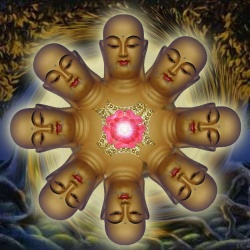Vejayanta
Vejayanta 1. Vejayanta. A pāsāda belonging to Sakka. When Moggallāna visited Sakka to discover if he had fully understood the Buddha's teaching in the Cūlatanhā sankhaya Sutta, Sakka tried to evade his questions by showing him this palace. It has one hundred towers, each seven stories high, with seven nymphs in each storey, waited on by seven attendants. The palace appeared in Tāvatimsa on the day of Sakka's decisive victory over the Asuras. Moggallāna allowed himself to be shown round, and then, with his big toe, he made the palace quake and rock.
M.i.252f.; cf. Thag. 1196f.; ThagA.ii.184. The palace was also made to rock by the novice Sangharakkhita (q.v.) on the day he joined the Order (DA.ii.558).
The palace is one thousand leagues high, and is so called because it arose in the hour of victory (J.i.203). It is decked with banners, each three hundred leagues long - banners of gold on jewelled staffs and vice versa; and the whole palace is built of the seven precious substances. It arose as the result of the rest house built by Sakka, in his birth as Magha, for the use of the multitude (DhA.i.273; cf. DA.iii.698). When the Buddha visited Tāvatimsa with Nanda, Sakka was in the palace with his crimson footed (kakutapādiniyo) nymphs and came forward with them to greet him. The nymphs had given oil for the massaging of Kassapa Buddha's feet, hence the colour of their own feet. SNA.i.274.
When King Sādhīna of Mithilā went to Tāvatimsa, he lived, according to human computation, seven hundred years in Vejayanta (J.iv.357).
The Vejayantapāsāda is illustrated on the Bharhut Tope. Cunningham, Bharhut Tope, p. 137.
2. Vejayanta. A chariot owned by Sakka, one hundred and fifty leagues in length (DA.ii.481; SA.i.261; J.i.202), and drawn by one thousand horses, with Mātali as charioteer (S.i.224).
Sakka rode into battle in this chariot (J.i.202), and it was sent to fetch distinguished humans to Tāvatimsa - e.g., Nimi, Guttila and Sādhīna (q.v.).
The Sudhābhojana Jātaka (J.v.408f ) contains a description of the chariot with its pole of gold and its framework overlaid with gilt representations of various animals and birds. When the chariot travelled the whole world was filled with the sound of its wheels.
3. Vejayanta. The chief of the eighty four thousand chariots owned by Mahāsudassana (S.iii.145; D.ii.187). The navel of its wheels was made of sapphire, the spokes of seven kinds of precious things, the rim of coral, the axle of silver, etc. SA.ii.237.
